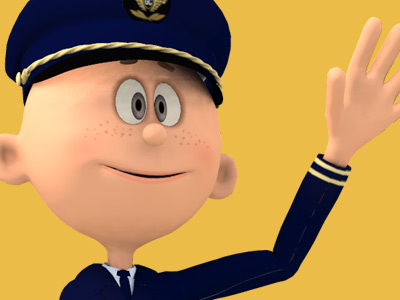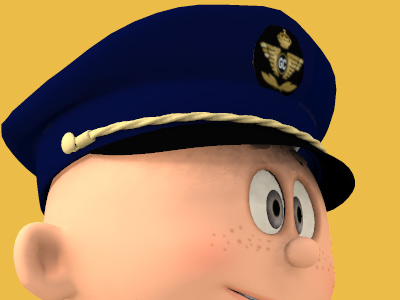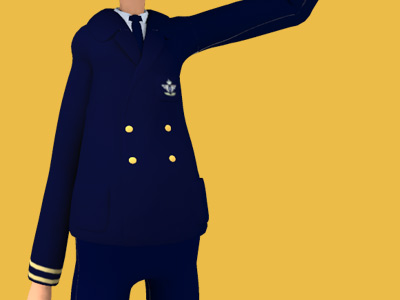Pilot Uniform
Airline pilot uniforms, the modern design which most people recognize as the attire worn by pilots operating large passenger aircraft, were introduced in the early 1930s by Pan American World Airways at the beginning of the Clipper era. At present, mainstream airline uniforms are somewhat standardized by the industry and widely used by airlines from the Americas, Europe, Asia, Australia and Africa, from small regional operators to large international companies.
History
Before the 1930s, pilots wore clothing derived from military tradition established during WW1. At this time, military issued pilots very practical and comfortable flight crew clothing, which consisted of leather bomber jackets with oversized front pockets to allow easy access to charts, scarves to keep their necks protected from cockpit drafts, khaki trousers, either black shoes or boots, and soft leather helmets with pockets for intercom or radio headsets. Such attire was quickly adopted or, more frequently, transferred to the civil aviation sector by ex-military pilots who, during peace time, worked in air mail and cargo transport, flying light open cockpit aircraft.
Things began to change in 1931, when Pan Am inaugurated its South American routes using Sikorsky S-38 and S-40 flying boats carrying the nicknames American Clipper, Southern Clipper, and Caribbean Clipper. They were the first of the series of 28 Clippers that came to symbolize Pan Am between 1931 and 1946. In 1937, Pan Am began seaplane service to Ireland, Britain and France from the United States. Six large, long-range Boeing 314 flying boats were delivered to Pan Am in early 1939. These enabled the commencement of a regular weekly transatlantic passenger and air mail service between the United States and Britain on June 24, 1939. Because Pan Am operated flying boats, the company decided to step away from the WWI military pilot look and dress their line pilots in an outfit closely resembling naval officer uniforms; the flight crews were just as much sea skippers as air pilots, and seeing a formally attired seafaring professional in the pilot seat allowed nervous passengers to feel more confident about the trip. Therefore, pilots were issued black trousers, black double-breasted blazers, with sleeve braid loops on the lower sleeves denoting crew member rank, and white officer-style combination caps with either gold or silver insignia depicting either airline name or logo. Pan Am's success in the 1930s, and quick development in the 1950s, led to the establishment of one of the largest and most well-known world-class airlines. Many other operators, wishing to emulate Pan Am's success, adopted the slick look of the PanAm pilot for their own crews.
Eighty years later, practically every airline in the world issues uniforms similar to naval-style Pan Am designs, regardless of the fact that the B314 or any other flying boats are no longer used in the mainstream commercial airline industry.
Uniform insignia
Following the development of advanced and integrated cockpit systems since the late 1980s, airline pilots are mainly operating their respective aircraft on a dual-pilot basis. Most crews consist of only a pilot (also known as captain) and a co-pilot (also known as a first officer). Systems integration and subsequent reduction in work-load, eliminated the need for additional crew members (also known as "ACM"), such as flight engineer, navigator, radio operator. However, since some older airliners are now used for cargo transportation, such extended crews still exist.
Cruise pilots, also known as "second officers", who are normally first officers in training and are allowed to pilot aircraft outside of "critical flight phases" when the airplane is cruising above 10,000 feet, may be present on longer flights as relief pilots.
Each crew member's uniform is decorated with insignia which, akin to naval uniforms, represents his or her duties on board the aircraft. The airline captain's insignia corresponds to the naval captain's insignia, such as four stripes on the shoulder epaulets and four stripes on the blazer arms. First officer's insignia corresponds to the naval commander uniform, bearing three stripes on shoulder epaulets and blazer arms. (On some airlines, less experienced first officers will wear two stripes.) ACM insignia is similar to naval lieutenant's uniforms, with two stripes.
Pilots also typically wear a winged badge inducating their qualification to fly and their seniority. The color typically matches the sleeve stripe color, and the badge may be a metal pin or an embroidered patch. They generally follow the pattern of having the corporate logo in the center. For US-based carriers, a captain generally has a star enclosed in a laurel wreath on top, similar to a command pilot in the US Air Force. A first officer has only a star, similar to a senior pilot in the USAF.
| Rank/Uniform item | Captain | First Officer | Additional Crew Member |
|---|---|---|---|
| Blazer | 4 stripes, gold or silver | 2 or 3 stripes, gold or silver | 2 stripes, gold or silver |
| Shirt epaulets | 4 stripes, gold or silver | 2 or 3 stripes, gold or silver | 2 stripes, gold or silver |
| Hat | Gold or silver chinstrap with braid design on visor | Gold or silver chinstrap | Black, gold or silver chinstrap |
| Wings | Gold or silver wings with a star enclosed in a laurel wreath | Gold or silver wings with a star | Gold or silver wings |





RESOURCES
This article uses material from the Wikipedia article "Airline pilot uniforms", which is released under the Creative Commons Attribution-Share-Alike License 3.0.
© Stories Preschool. All Rights Reserved.





